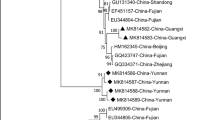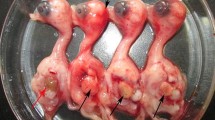Abstract
Duck circovirus (DuCV), a potential immunosuppressive virus, was investigated in Southern China from March 2006 to December 2009 by using a polymerase chain reaction (PCR) based method. In this study, a total of 138 sick or dead duck samples from 18 different farms were examined with an average DuCV infection rate of ∼35%. It was found that ducks between the ages of 40∼60 days were more susceptible to DuCV. There was no evidence showing that the DuCV virus was capable of vertical transmission. Farms with positive PCR results exhibited no regularly apparent clinical abnormalities such as feathering disorders, growth retardation or lower-than-average weight. The complete genomes of 9 strains from Fujian Province and 1 from Zhejiang Province were sequenced and analyzed. The 10 DuCV genomes, compared with others genomes downloaded from GenBank, ranged in size from 1988 to 1996 base pairs, with sequence identities ranging from 83.2% to 99.8%. Phylogenetic analysis based on genome sequences demonstrated that DuCVs can be divided into two distinct genetic genotypes, Group I (the Euro-USA lineage) and Group II (the Taiwan lineage), with approximately 10.0% genetic difference between the two types. Molecular epidemiological data suggest there is no obvious difference among DuCV strains isolated from different geographic locations or different species, including Duck, Muscovy duck, Mule duck, Cheery duck, Mulard duck and Pekin duck.
Similar content being viewed by others
References
Banda A, Galloway-Haskins R I, Sandhu T S, et al. 2007. Genetic analysis of a duck circovirus detected in commercial Pekin ducks in New York. Avian Dis, 51: 90–95.
Chen C L, Wang P X, Lee M S, et al. 2006. Development of a polymerase chain reaction procedure for detection and differentiation of duck and goose circovirus. Avian Dis, 50: 92–95.
Eisenberg S W F, van Asten A J A M, van Ederen A M, et al. 2003. Detection of circovirus with a polymerase chain reaction in the ostrich (Struthio camelus) on a farm in The Netherlands. Vet Microbiol, 95: 27–38.
Faurez F, Dory D, Grasland B, et al. 2009. Replication of porcine circoviruses. Virol J, 18: 60.
Fringuelli E, Scott AN, Beckett A, et al. 2005. Diagnosis of duck circovirus infections by conventional and real-time polymerase chain reaction tests. Avian Pathol, 34: 495–500.
Fu G, Cheng L, Shi S, et al. 2008. Genome Cloning and Sequence Analysis of Duck Circovirus. Chin J Virol, 24:138–143.(in Chinese)
Halami M Y, Nieper H, Müller H, et al. 2008. Detection of a novel circovirus in mute swans (Cygnus olor) by using nested broad-spectrum PCR. Virus Res, 132: 208–212.
Hattermann K, Schmitt C, Soike D, et al. 2003. Cloning and sequencing of Duck circovirus (DuCV). Arch Virol, 148: 2471–2480.
Hughes A L, Piontkivska H. 2008. Nucleotide sequence polymorphism in circoviruses. Infect Genet Evol, 8: 130–138.
Jiang S, Zhang X, Liu S, et al. 2008. PCR detection and sequence Analysis of duck circovirus in sick Muscovy ducks. Virol Sin, 23: 265–271.
Johne R, Fernández-de-Luco D, Höfle U, et al. 2006. Genome of a novel circovirus of starlings, amplified by multiply primed rolling-circle amplification. J Gen Virol, 87: 1189–1195.
Li M, Song Y, Wen N, et al. 2009. PCR detection and sequence analysis of duck circovirus infection in Xinxing County of Guangdong Province. Chin Vet Sci, 39: 164–167. (in Chinese)
Mankertz A, Hattermann K, Ehlers B, et al. 2000. Cloning and sequencing of columbid circovirus (CoCV), a new circovirus from pigeons. Arch Virol, 145: 2469–2479.
Pheix K V, Weston J H, Ypelaar I, et al. 2001. Nucleotide sequence analysis of a novel circvirus of canaries and its relationship to other members of the genus Circovirus of the family Circoviridae. J Gen Virol, 82: 2805–2809.
Rahaus M, Dwsloges N, Probst S, et al. 2008. Detection of beak and feather disease virus DNA in embryonated eggs of psittacine birds. Vet Med-Czech, 53: 53–58.
Raidal S R, Riddoch P A. 1997. A feather disease in Senegal doves (Streptopelia senegalensis) morphologically similar to psittacine beak and feather disease. Avian Pathol, 26: 829–836.
Schat K A. 2009. Chicken anemia virus. Curr Top Microbiol Immunol, 331: 151–183.
Shi S, Chen Z, Yang W, et al. 2009. Genomic sequence analysis of duck circovirus and prokaryotic expression of its C1 truncated gene. Chin J Vet Sci, 29: 1269–1273. (in Chinese)
Shi S, Fu G, Cheng L, et al. 2010. Sequencing and analysis of genome of duck circovirus PT07. Chin J Prev Vet Med, 32: 235–237. (in Chinese)
Soike D, Albrecht K, Hattermann K, et al. 2004. Novel circovirus in mulard ducks with developmental and feathering disorders. Vet Rec, 154: 792–793.
Soike D, Kohler B, Albrecht K. 1999. A circovirus-like infection in geese related to a runting syndrome. Avian Pathol, 28: 199–202.
Stewart M E, Perry R, Raidal S R. 2006. Identification of a novel circovirus in Australian ravens (Corvus coronoides) with feather disease. Avian Pathol, 35: 86–92.
Tamura K, Dudley J, Nei M, et al. 2007. MEGA4: Molecular Evolutionary Genetics Analysis (MEGA) software version 4.0. Mol Biol Evol, 24: 1596–1599.
Todd D, Fringuelli E, Scott A N, et al. 2008. Sequence comparison of pigeon circoviruses. Res Vet Sci, 84: 311–319.
Todd D, Scott A N, Fringuelli E, et al. 2007. Molecular characterization of novel circoviruses from finch and gull. Avian Pathol, 36: 75–81.
Todd D, Weston J, Ball N W, et al. 2001. Nucleotide sequence-based identification of a novel circovirus of canaries. Avian Pathol, 30: 321–325.
Todd D, Weston J H, Soike D, et al. 2001. Genome sequence determinations and analyses of novel circoviruses from goose and pigeon. Virology, 286: 354–362.
Todd D. 2004. Avian circovirus diseases. Lessons for the study of PMWS. Vet Microbiol, 98: 169–174.
Yu X, Zhu C, Zheng X, et al. 2007. Genome analysis and epidemiological investigation of goose circovirus detected in eastern China. Virus Genes, 35. 605–609.
Zhang X, Jiang S, Wu J, et al. 2009. An investigation of duck circovirus and co-infection in Cherry Valley ducks in Shandong Province, China. Vet Microbiol, 133: 252–256.
Author information
Authors and Affiliations
Corresponding author
Additional information
Foundation items: Modern Agri-industry Technology Research System (CARS-43); Science and Technology Innovation Fund of Fujian Academy of Agriculture Science (STIF-02); Science and Technology Innovation Foundation for Young Scientists of Fujian Academy of Agriculture Science (2008QB-6).
Rights and permissions
About this article
Cite this article
Wan, Ch., Fu, Gh., Shi, Sh. et al. Epidemiological investigation and genome analysis of duck circovirus in Southern China. Virol. Sin. 26, 289–296 (2011). https://doi.org/10.1007/s12250-011-3192-y
Received:
Accepted:
Published:
Issue Date:
DOI: https://doi.org/10.1007/s12250-011-3192-y




